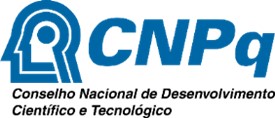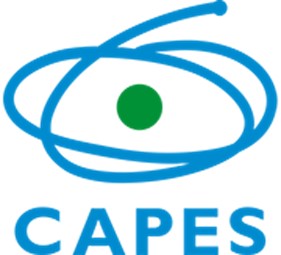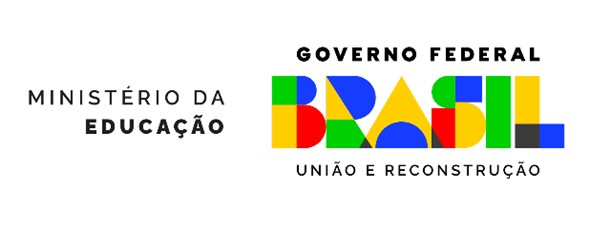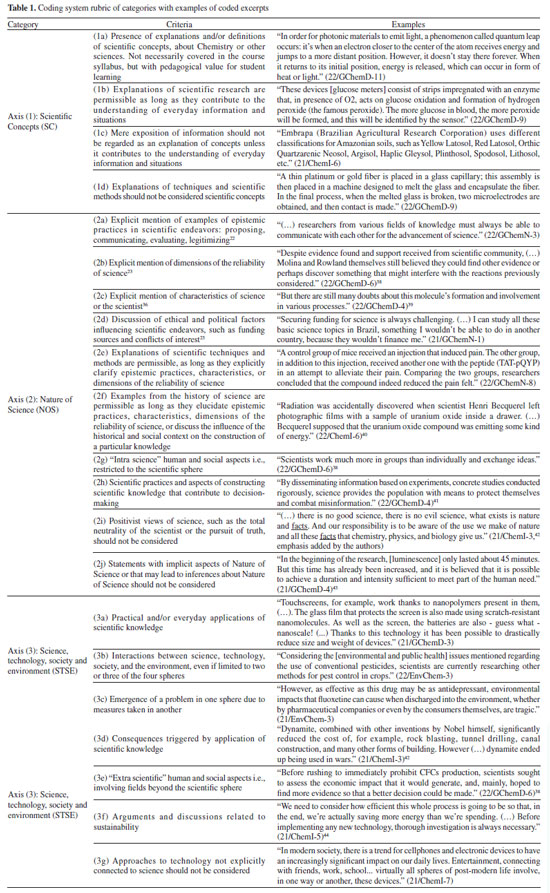Educação
| Promoting undergraduate students' scientific literacy through a science communication project |
|
Melina MurgelI,* I. Instituto de Química, Universidade de São Paulo, 05508-900 São Paulo - SP, Brasil Received: 01/16/2025 *e-mail: melmurgel@usp.br Misinformation is a pervasive threat to democracy, human health, the environment, and many other spheres touched by society. This raises concern about what citizens need to know so they can identify and avoid false claims, making individual and collective decisions based on evidence. Reliable scientific knowledge reaches the public through science communication. However, simply communicating ready-made claims is not enough to empower people in their daily decision-making. Aiming to contribute with possible pathways for science education for social transformation, a didactic activity in which undergraduate students designed science communication pieces was developed. It was implemented in three different undergraduate Chemistry courses, resulting in 67 science communication pieces. This study aimed to identify indications of scientific literacy in students' productions by analyzing them for the presence of the Structural Axes of Scientific Literacy. The results showed that the majority of the pieces presented axes (1) Scientific Concepts and (3) Science, Technology, Society, and Environment (STSE), while axis (2) Nature of Science (NOS) was addressed in about one-third of them. This reinforces that epistemology of science needs to be highlighted in science education curricula and practice. Yet, based on the results, the science communication pieces complied with socially engaged scientific literacy. INTRODUCTION The debate over misinformation has gained new momentum in recent years. Intake of medical drugs with no evidence of efficacy resulting in dangerous adverse effects, and vaccine refusal are a few examples of how misinformation increased coronavirus disease 2019 (COVID-19) pandemic's lethality.1,2 World Health Organization described this alarming spread of false information as "infodemic".3 Therefore, it is essential to raise awareness of the need to promote understanding of community concerns and questions, thereby building people's resilience to misinformation.3 Nonetheless, the impacts of misinformation are not restricted to health harm, but several other aspects of society affected by science denial and conspiracy theories, such as the climate crisis.4,5 During the COVID-19 pandemic, governmental and individual decision-making influenced by non- or anti-scientific claims such as those exemplified above showed its worst possible outcome, leading to an unmeasurable - and avoidable - loss of human life.1,6,7 Therewith, a question emerges: what does citizens need to know so they can make individual and collective decisions based on evidence? Science offers reliable data, evidence, and claims, but accessing and understanding scientific information is difficult for non-experts.4 Quite often, when the media reports scientific findings detached from its epistemic processes in order to keep its merchandise appeal, the sale of ready-made claims can undermine their trustworthiness.8 Moreover, when scientists are asked to explain their findings, they frequently cannot manage to convey their conclusions beyond expert audiences.4 Since we cannot expect all citizens to be experts in all science fields to understand what scientists say and make evidence-based decisions, the answer lies in communicating scientific knowledge in a manner that is accessible to all. However, scientists have little training on how to communicate to a broad audience, and most people think that the work ends in reporting their findings to peers.4 Additionally, one can argue that getting involved in controversial issues could hinder scientists' objectivity. But this aloofness leaves scientific knowledge open to misrepresentation, as we have been seeing before.1,2,4 Therefore, we propose science communication and scientific literacy as remedies for such issues. Several studies have explored ways to develop scientific literacy and train future scientists to communicate more effectively with a broad audience. Some examples can be found in biochemical education, in which undergraduate students produced science communication pieces on COVID-19, research seminars, and bacteria.9-11 Yet, most approaches found in literature demand alteration in teachers' practice. That may seem obviously necessary, although is a great challenge for science education,5 as not all teachers feel prepared or willing to change how they teach. For this reason, research on auxiliary strategies is needed to provide insights on how to succeed in the transition to teaching-learning approaches aiming critical scientific literacy. Scientific literacy What the average citizen should know about science concerns their scientific literacy. The answer, however, varies broadly according to interest groups, purposes, meaning conveyed to literacy, ways of measuring, etc.12 Roberts13 proposes a continuum for scientific literacy interpretations found in literature. At one end is Vision-I, concerned about science processes and products.13 This is the traditional approach in science education practice, focused almost exclusively on teaching scientific concepts.5,13,14 At the far edge lies Vision-II, which incorporates real life situations involving science-related issues.13 Vision-II relates to social usefulness of scientific knowledge, considering meaningful Science, Technology, Society, and Environment (STSE) contexts.14 In addition to it, Valladares argues based on a documentary analysis of the main views of scientific literacy that the concept must be updated to address the challenges of the 21st century.14 In order to educate citizens able to handle the current social, ecological, political, and economic crises, scientific literacy ought to incorporate social activism and action towards social transformation, the so-called Vision-III.5,14 Unlike Roberts, Silva and Sasseron5 understand Visions I and II as complementary, arguing that to employ scientific knowledge in daily life people need to understand scientific concepts. Similarly, to achieve Vision-III one also has to comprehend Visions I and II.5 Most conceptual definitions of scientific literacy align with Miller's three dimensions - Nature of Science; key scientific terms and concepts; and impact of science and technology in society -, which is also the case of the Structural Axes of Scientific Literacy proposed by Sasseron and Carvalho.15 In this work, scientific literacy is understood from the definition of literacy proposed by the Brazilian educator Paulo Freire16 and defended by Sasseron and Carvalho,15 Valladares14 and Silva and Sasseron.5 Literacy so implies the connection between the world and the written word, that is, the literate one is capable of constructing meanings from what one reads, relating it to what one experiences.15 In this sense, "reading science" as proposed by scientific literacy does not end in mere understanding of its results, but in the ability to, more than understand, establish relationships between science and everyday life.15,16 This, ultimately, enables individuals to intervene in their environment based on critical decisons.17 With that in mind, for transformative scientific literacy to be achieved, it is not enough to simply communicate scientific knowledge, it is also necessary to emphasize the epistemology of science and its socioenvironmental influences. Hence in this work the so-called Structural Axes of Scientific Literacy, proposed by Sasseron and Carvalho15 were adopted as theoretical framework to analyze scientific literacy. The Structural Axes emerged from a bibliographic review that identified skills and attitudes deemed necessary to consider someone scientifically literate. The axes were proposed aiming to form citizens capable of critically engaging in society.15 This proposal lines are aligned with the idea that Visions I, II and III of scientific literacy are complementary, therefore all required for transformative science education.5 Silva and Sasseron5 also relate the Structural Axes of Scientific Literacy to four scientific knowledge domains: conceptual, epistemic, social, and material. Duschl18 argues that science education should balance three domains of scientific knowledge: conceptual, epistemic, and social. The conceptual domain is traditionally emphasized in science classes, which considers teaching science as transmitting the meaning of scientific terms.5,19 However, the author points out that epistemic and social domains should be integrated to the conceptual domain and incorporated in science education practice.18 The epistemic domain involves norms and criteria necessary to evaluate scientific knowledge, i.e., how to decide whether a claim is reliable or not.5,18,20 The social domain consists of processes and contexts by which knowledge is collectively discussed and constructed.5,18,20 In addition to these three domains, Stroupe20 considers a fourth dimension, the material domain. The material domain comprises how instruments, tools and technology are employed in scientific practices.5,20 This theoretical framework is summarized in Figure 1.
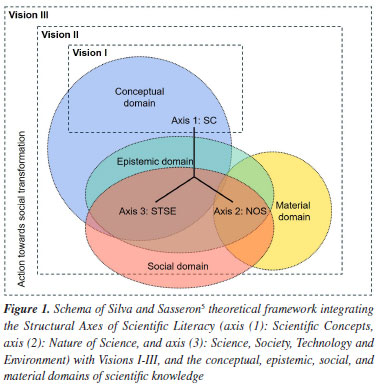
The first Structural Axis of Scientific Literacy is knowledge of scientific concepts. Students are not supposed to know all concepts, laws, and theories, but to have basic comprehension of key concepts.15 Axis (1) Scientific Concepts is aligned with Vision-I, both privileging the conceptual domain of scientific knowledge.5 Vision-I has a positivist perspective of science as isolated from society,5 and the conceptual domain concerns the concepts and cognitive processes employed on scientific reasoning.18 Axis (1) can present elements of the Vision-II if scientific concepts are contrasted with students' previous misconceptions from their daily life.5 To reach Vision-III, axis (1) must be merged with the epistemic, material and social domains.14 Axis (2) Nature of Science is the most complex one, as it encompasses social, epistemic, and material domains involved in scientific knowledge production.5 Additionally, there is no consensus among philosophers about the Nature of Science itself.21 However, there are teaching strategies considered efficient for teaching Nature of Science. They are based on evoking real-life situations instead of general principles and integrating Nature of Science with other learning objectives, for instance, by approaching students' own inquiry activities, contemporary cases, and historical cases.21 Therefore, by discussing how epistemic practices of science make it reliable and how comprehension of the social processes involved in science allows to scrutinize scientific claims, axis (2) is addressed. The main epistemic practices for science education are identified by Kelly and Licona22 as propose, communicate, evaluate, and legitimize. And its dimensions of reliability, inventoried by Allchin23 in three dimensions: observational (observations and measurements, experiments, instruments); conceptual (patterns of reasoning, historical dimensions, human dimensions); and sociocultural (institutions, biases, economics/funding, communication). Understanding the Nature of Science allows students to participate in debates about science-related issues, which composes Vision-III.5 Furthermore, the third axis of scientific literacy should be met by discussing influences between Science, Technology, Society, and Environment (STSE). This approach can be done through the lens of solving problems through technology; historical and sociocultural embeddedness of science; considering scientific evidence in decision making; ethics and moral reasoning-oriented decision making; science and technology within a broader sociocultural context; and/or agency for solving social and ecological issues.24 Axis (3) STSE coincides with Vision-II when it comes to STSE interrelationships and daily decision making.5 Yet, STSE discussions ought to combine the conceptual domain with the epistemic and social ones, so students can analyze situations and adopt a stance for decision-making.5 This axis can be articulated with socioenvironmental activism to meet Vision-III and reach sociopolitical engagement.5 In this way, scientific cultures can guide critical civic action by empowering people in their individual and collective decision-making. Therefore, scientific literacy is essential for democracy as it constitutes a tool for social inclusion, allowing the population to participate in socio-scientific debates and decision-making that permeate their reality.12,25-27 Therewith, science communication plays an important role in bridging the gap between science and the general population. Science communication As formerly argued, this work is grounded in the premise that science communication has the potential to contribute to citizens' scientific literacy28,29 - what Guimarães30 terms "emancipatory science communication". However, not all science communication fulfills this potential. To effectively foster scientific literacy, science communication must incorporate all three axes of scientific literacy, though their presence alone does not guarantee such an outcome.30 Science communication arises from the interaction between the scientific sphere and other social spheres - such as media and education -, in a movement of dialogue between theory and practice.8,31 By doing so, science communication seeks to extend access to scientific knowledge beyond specialists. This is done by the recodification of specialized discourse, transposing it to non-specialized language, understandable by a lay audience.32 However, mere communication of results is of little use to citizens. Höttecke and Allchin33 draw attention to the new reality created by the advancement of social media, in which people need, more than ever, to discern reliable and unreliable information on their own. The central question raised by the authors is "who can reliably speak for science?". Since experts speak to other experts, the interaction between science and society needs to be mediated by science communicators.33 Some assets are employed to recode the specialized discourse and make it accessible to a broad audience. By analyzing texts from mass-circulation science communication magazines, Zamboni34 identified as main features of science communication: initial plea for reading (strategies to capture readers' interest in the first contact with the text); attractiveness (strategies to keep the readers' interest during reading, such as dialogue with the audience, visual formatting, and engaging narratives); explanations (such as tacit knowledge retrieval); pursuit of credibility (by describing the source of information and its relevance to the field); and scrutiny of research methodology and prudence in the face of results (in an evaluative and prudent attitude towards research methodology, results and conclusions). Thus, this paper aims to explore the potential of science communication to foster scientific literacy Vision-III. Thereto, the study examined, based on the theoretical framework of the Structural Axes of Scientific Literacy,15 science communication pieces created by undergraduate students in three Chemistry courses at different stages of their programs.
METHODS The study was conducted in three courses: Chemistry I, offered in the first semester of bachelor degree in Molecular Sciences; General Chemistry II, offered in the second semester of Chemistry degrees for two classes, daytime and nighttime; and Environmental Chemistry III, offered in the 10th semester of an elective emphasis on Environmental Chemistry for bachelor's degree in Chemistry. All classes had the same person as teaching assistant and different teachers. The project was conducted via emergency remote teaching in 2021 due to the COVID-19 pandemic, and in person in 2022. Google Meets platform was used for online synchronous meetings, and, in both years, Moodle virtual environment for sharing materials. The same procedure was followed in 2021 and 2022, maintaining the courses, syllabi, teachers, and teaching assistant. In total, 369 students (forming 69 groups) carried out the project until the end. Of these, 194 (36 groups) participated via emergency remote teaching in 2021, and 175 (33 groups) joined in-person in 2022 - a detailed distribution of students and groups by class is available in the Supplementary Material. Science Communication Project The Science Communication Project consisted in the creation of science communication pieces by undergraduate students enrolled in Chemistry courses. The project sought to complement traditional lectures by providing Nature of Science and STSE perspectives regarding the courses content. It aimed as learning objectives for students to: (i) ensure trustworthiness based on reliable sources of information; (ii) explain scientific concepts in lay terms; and (iii) discuss the STSE relations regarding a chosen topic. In order to meet these objectives, the following assessment criteria were stablished:
As an accessory activity, time devoted to the project was not enough to delve deeper into Nature of Science and STSE discussions during classes. Due to its complexity, Nature of Science needs to be directly addressed for students to understand it;5 for this reason, this axis was not included in the assessment criteria. On the other hand, the assessment criteria explicitly required STSE considerations and comprehensive analysis, encouraging students to discuss and address issues they found socially meaningful. To provide flexibility to students, the groups could choose the media format, length, and complexity of the science communication pieces, leaving students free to decide to do something compatible with their skills and available time. Therefore, the assessment was qualitative, not quantitative, and guided by a rubric. The project composed half of the courses final score, intending to incentivize students to complete it. Figure 2 shows the project workflow. The introduction consisted of a lesson highlighting the gap between science and society, proposing science communication as a possible bridge between them. Contextualization on science communication was provided, and its role as a manner to return to society the investment made in public universities - i.e., in the education of the students themselves -, was pointed out. Characteristics and examples of science communication were also discussed, drawing attention to the imperative of using understandable language to non-specialists and establishing relationships between scientific content and daily life. This debate had the intent of engaging students with the importance of science communication. And the assessment criteria were presented before the beginning of the project, so they could act as guidelines for students.
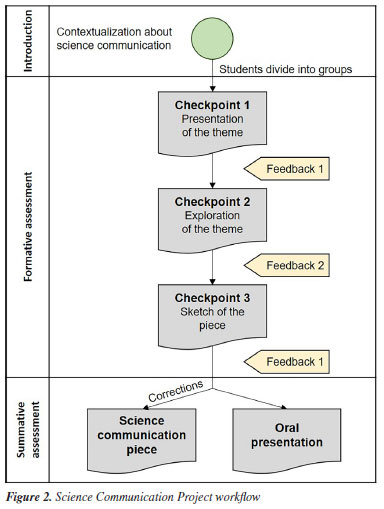
During the production of science communication pieces, groups delivered three checkpoints. The content of the checkpoints was determined by the adjustments made to each course, but they followed a logical sequence intended to help students designing the science communication pieces. Checkpoint 1 consisted of a presentation of the theme. In Chemistry I, groups chose and introduced a theme, previously validated by the teacher and the teaching assistant. In General Chemistry II, groups chose a faculty member to interview and prepared questions for the conversation. In Environmental Chemistry III, groups chose a real environmental issue and a Green Chemistry solution for it and explained them. For checkpoint 2, students explored the theme in depth, delimiting their focus and explicitly relating it to the courses content. In Chemistry I, a Wikipedia page was edited or created. In General Chemistry II, main quotations of the interview were transcribed, selecting relevant aspects to be communicated. In Environmental Chemistry III, the green solution was compared with conventional solutions through Green Chemistry metrics and principles. Finally, for checkpoint 3 a draft of the science communication piece was prepared as detailed as possible, so changes and corrections could be made before the completion of the project. After every checkpoint and before the delivery of the next one, the teaching assistant provided written feedback on the progress presented, considering the assessment criteria. Lectures provided by the teachers strongly aligned with Vision-I, which is the conventional focus of academic training.14 In Chemistry I, aspects of the Nature of Science and meaningful contexts were employed to support explanations, which are characteristics of Vision-II. General Chemistry II was taught by an experienced lecturer, and problem-solving classes were dedicated for students to practice scientific concepts. Environmental Chemistry III syllabus was inherently related to STSE, as this course aimed to discuss how to reduce environmental impact of chemical processes, which also overlaps Vision-II. However, in Visions I and II science and society are detached.14 Hence, the classes did not encourage socio-political action as required by Vision-III. Considering that the three visions rely on each other and that all three should be addressed, the Science Communication Project aimed to stimulate students to reflect on social and environmental issues, and how science, "constituting and being constituted by society", can contribute to solutions.14 As the project closure, each group presented their science communication piece to the class. They commented on its creation process, and discussed chemical concepts in more depth than in the science communication piece, covering topics from the course program and considering an audience of future chemists, who are more familiarized with the subject than the broad public of science communication. At the end of each semester, the groups that consented had their pieces displayed in a virtual Science Communication Exhibition, available on the Institute of Chemistry website.35 The webpage compiles all works created within the Science Communication Project in the three courses from 2020 to 2023. The pieces analyzed in this study can be identified by their themes, which are listed in the Supplementary Material. Analysis of Structuring Axes of Scientific Literacy in the science communication pieces The science communication pieces produced by the students were classified according to the presence or absence of each of the Structuring Axes of Scientific Literacy, namely:15
Data was coded in MAXQDA software (2022 Analytics Pro, VERBI, Germany, 2021) by two evaluators separately. The first evaluator participated in the projects' development as the teaching assistant, and the second was an external evaluator with no relationship with the classes, participating with the purpose of validating the analysis. The first coding rubric was assembled based on floating reading of the students' productions.37 Then some pieces were analyzed based on these initial criteria, and adjustments were made by including new criteria to comprise unanticipated cases and rewriting initial criteria to better encompass the data. This first version of the rubric was used by both evaluators to analyze a sample of 20 pieces. Then, the codes were compared, and the divergences were discussed to understand variations on interpretation of criteria. The rubric was rewritten, resulting in its final version, whose criteria are specified in Table 1. The final version of the rubric was used by both evaluators to categorize the whole corpus. After individual analyses, categories attributed to each science communication piece were compared, and discordant categorizations were discussed until reaching consensus on which Structuring Axes of Scientific Literacy were present or not in each piece. The column Examples in Table 1 shows some excerpts of the students' productions to illustrate statements categorized according to each criterion.
RESULTS AND DISCUSSION From the 69 groups, 67 science communication pieces were collected. Two pieces were excluded from analyses because they did not meet any of the science communication features34 previously mentioned. Therefore, they could not be considered science communication pieces. Some videos resembled recorded seminars; however, they were included in the corpus because they fulfilled the educational goals. Students researched in scientific literature (goal a), employed comprehensible language for non-specialists (goal b), and discussed STSE aspects (goal c), even though the pieces lacked other science communication features, such as attractiveness, dialogue with the audience and engagement formulas.34 This tendency toward seminars could be due to students' unfamiliarity with science communication, intensified by previous experience with seminars. Therefore, it seems fruitful to request students more diverse tasks. The project's open-ended character allowed students to explore subject matter in varying levels of complexity, justifying its suitability for whichever undergraduate semester. It gives them the autonomy to progress in the task at their own pace, according to their learning process. Qualitative analysis identified axes (1) Scientific Concepts and (3) STSE in the majority of science communication pieces (88 and 96%, respectively), and axis (2) Nature of Science was the least frequent (37%). Checking for the axes present in each science communication piece (Figure 3), most of them contemplate axes (1) Scientific Concepts and (3) STSE (36 pieces) or all three axes (20 pieces). These two groups describe de majority of the corpus (84%), thus being held representative of the collected data.
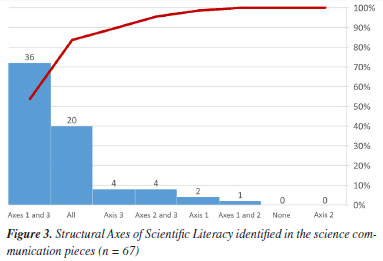
Scientific concepts and STSE relations were consistently prioritized over Nature of Science. Even though the courses had different approaches, more attention was given to axis (1) during classes. Whereas, axis (3) was frequently detected probably due to two factors: STSE discussion was part of assessment criteria; and axis (3) is more tangible to students than axis (2). Chemistry I was part of an undergraduate program focused on training future scientists, and in General Chemistry II the project aimed to acquaint students with the work of real scientists, while Environmental Chemistry III concerned industrial chemical processes environmental impacts. These different approaches are reflected on the presence of axis (2) in the science communication pieces produced in each course. The lower frequency of axis (2) Nature of Science related to the other two axes can be justified by its complexity.5 As axis (2) coordinates elements from epistemic, material, and social domains, it is expected to be more difficult to be taught and learned.5 For this reason, the project should provide better outputs when aligned with discussion about Nature of Science during classes. The similar presence of axis (1) Scientific Concepts among the courses (Figure 4) suggests that the conceptual domain was explored in accordance with students' academic development stages, aligning with courses syllabi. The equivalent presence of axis (3) STSE indicates that integration of conceptual, social, and epistemic domains was also compatible with students' maturity level. The conceptual domain (axis (1)) was mainly discussed during lectures, with no considerable variation from online to in-person mode. Epistemic, social, and material domains, also approached by the teachers, although not as the main focus, were emphasized during the project. Students investigated the Nature of Science and STSE relations during active research work, and the axes discussion was assessed by written feedback from the teaching assistant - excerpts of checkpoints and feedback provided are available in the Supplementary Material. Axis (2) Nature of Science was the least present across the classes, which reinforces that teaching and learning Nature of Science is challenging in all educational levels, but also provides insight about how it can be done.
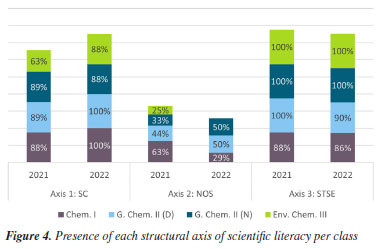
Axis (1) Scientific Concepts As pointed out, the Science Communication Project was adapted to courses syllabi, assisting students in different undergraduate stages. Since the project focused more on knowledge "about" science than on knowledge "in" science, it allowed students to explore and approach topics beyond the Chemistry contents taught in the classroom. Some pieces produced in General Chemistry II introduced scientific concepts with a gradual increase of complexity, in a sequence analogous to those found in textbooks. They began explaining basic Chemistry concepts such as atomic model, quantum leap and redox reactions. From that, more complex ideas were presented, addressing the group's theme. In this course, first-year students conducted interviews on ongoing research, reflecting what Latour calls "science-in-the-making".45 As noted by Silva and Sasseron,5 students are typically unfamiliar with such uncertainty, as textbooks often present ready-made science as certain, static, and unproblematic knowledge. However, science-in-the-making is filled with uncertainty, controversies, competition, and error.45 It is difficult for non-scientists to cope with these aspects, and to understand them as part of the epistemic practices that make science reliable.4,21,23,27 Moreover, other pieces started with explanations of specialized terms central to the theme, like polymers and spectroscopy. This recovery of tacit knowledge, by presuming what the audience does not know, seeks to explain terms and concepts familiar and well stablished among experts, but unknown or unclear for non-specialists.34 Outlining what the interlocutor does not know is important to science communication,34 however, it is difficult to define a uniform set of previous knowledge that applies to an audience as broad as "non-experts". Furthermore, scientific concepts in science communication can be used as nominations (when science communicators repeat terms used by scientists) or as definitions (when the meaning of a term is employed by both scientist and science communicator).34 In students' productions, both linguistic forms appeared, integrated in or separated from the main text. The use of glossaries drew attention for exempting students from adapting the scientific discourse to a more accessible language. By doing that, students avoided rewriting specialized knowledge in lay terms. Similar to glossaries, some other pieces defined scientific terms separated from the text, but along it, in boxes or specific sections. Boxes are useful for segmenting information and keeping readers' interest, but to do so they should provide appealing information, not technical nominations.34 Yet, in most cases, scientific concepts appeared as integrated definitions. The use of definitions indicates that students acquired the terms' meanings. In that sense, it can be considered that the concept domain was satisfied, along with scientific literacy Vision-I. Writing about scientific concepts for a lay audience shifts the focus from writing to the teacher - as an interlocutor who knows the topic and will evaluate the writer - to sharing knowledge. Such a change helps to make writing part of the learning process instead of something done after learning.19 This modification, however, poses a challenge for students, who must be frequently reminded that their target audience consists of laypeople rather than the teacher. Another strategy to include writing in the learning process is to do it collaboratively, so students can learn from each other.19 Therefore, the Science Communication Project contributes with these two aspects to engage students in writing as part of learning. Furthermore, scientific literacy Vision-II requires axis (1) scientific knowledge to be contrasted with misconceptions.5 Such attitude was identified in a few cases in which students refuted misinformation or pseudo-sciences. Axis (2) Nature of Science Axis (2) Nature of Science involves social, epistemic, and material domains.5 These three domains should be considered as important as the conceptual domain for science education, which "cannot be reduced to the assimilation of facts, the mimicking of procedures, or the ‘correction' of misconceptions".20 Social and epistemic domains were explored in 37% of science communication pieces. Material domain, however, was poorly approached. It does not mean that students did not have contact with material domain, however, they did not include it in science communication pieces. Material domain can be developed in inquiry activities or manipulative or intellectual work.5 Meaningful aspects of Nature of Science identified in the science communication pieces can be described from Allchin23 partial inventory of dimensions of reliability in science, such as collaboration among scientists, consilience with established evidence, empiricism, models, alternative explanations, and sources of funding. They appear alone or combined, as in this example of collaboration among scientists and empiricism:
History of science was cited in many pieces. Some did that only in expository way, while others approached aspects of Nature of Science, like in this excerpt which illustrates conceptual change and alternative explanations with subsequent theory development:
Nature of Science was the main focus of only one science communication piece, whose theme was "is science good or evil?" (podcast 21/ChemI-3).42 In all other pieces, axis (2) was merged with other ideas, like the previous excerpt, or presented separately, as in this warning in the beginning of a video:
Duschl and Grandy emphasize that Nature of Science should be thought within context, from which students can develop understanding of its practices, materials, and technologies, so they can build and refine a model of how scientific knowledge is constructed.48 Allchin23 recommends using history of science to do this. As seen, students are familiarized with approaching history of a given subject to introduce it, but they need guidance to identify and discuss Nature of Science in the narratives. Students demonstrated understanding of science limitations and some situations in which they need to be considered. However, they did not clearly articulate when to apply this knowledge nor thoroughly discussed the aspects that make science reliable. The science communication pieces that approached axis (2) Nature of Science achieved scientific literacy Vision-II insofar as the Nature of Science was discussed. Nevertheless, Vision-III requires action.14 Science communication initiatives such as museums can play a role on raising awareness about socioenvironmental issues, becoming precursors to activism for social, environmental, and political transformation.49 Hence, albeit few pieces addressed public science-related debates, the production of science communication pieces itself can be considered a form of social action. Therefore, data reinforces the imperativeness of giving due space to epistemology of science in the curriculum. Epistemic, social, and material domains cannot be neglected in science education, whereas only lecturing about them is inconsistent with Nature of Science itself.5 It requires change in instruction and assessment methods.18 To promote scientific literacy Vision-III, classes should approach the Nature of Science complexity, and allow students to construct their own comprehension of what science is and how its ways of reasoning can help to analyze daily situations.5 In this sense, the version of the project implemented in General Chemistry II can be particularly fruitful, as students inquired science-in-the-making through interviews with actual researchers. Axis (3) Science, Technology, Society, Environment Axis (3) coordinates conceptual, social, and epistemic domains.5 During lectures, Environmental Chemistry III course had special focus on STSE discussion, as the course syllabus included Green Chemistry, applied biotechnology, and Sustainable Development Goals (SDG) - inherently STSE topics. Thus, this course approached the conceptual, social, and epistemic domains also in lectures, which were reinforced by the Science Communication Project. Scientific literacy Vision-II aims to support daily decision-making,5,13 and Environmental Chemistry III sought to prepare future chemists for sustainable decision-making in their professional activities, which aligns to Vision-III. Addressing the conceptual domain in real and realistic socioenvironmental situations prepares future chemists for critical action and problem-solving.5 Moreover, once scientific literacy visions are complementary, critical professional decision-making (Vision-III) is also based on conceptual foundation (Vision-I) provided by other courses within the program, such as General Chemistry II. Most pieces approached STSE from an application/design perspective, focusing on technological solutions for practical problems.24 Although the six STSE currents are not mutually excluding, other approaches portrayed by Pedretti and Nazir were not significantly identified in the science communication pieces. It could be improved by class discussions on Socioscientific Issues and alternative solutions.24 Students mainly addressed application of scientific knowledge and problem solving through science and technology. However, they did it theoretically, that is, no artefacts or pieces of technology were designed as exemplified by the authors. The following excerpts illustrate the students' perception of technology development as solution for objective problems:
Especially in 2021 classes, examples of applications related to COVID-19 were common - for instance, a group chose antisepsis as their theme (magazine 21/ChemI-1).51 This indicates that students related science with the moment they were living, like in the excerpt below:
Another frequent topic was the environmental impact of technology, and scientific solutions for it. This topic appeared mainly in pieces produced in Environmental Chemistry III, because in this course students were instructed to create science communication videos about an environmental issue and a green solution for it. In these cases, Green Chemistry was presented as the subject responsible for creating such solutions:
STSE influences discussed by students demonstrated different thoroughness levels. They varied from mentioning practical uses, to brief descriptions, to more elaborated explanations about how science and technology can impact society and the environment. From Pedretti and Nazir's24 perspective of STSE education tenets, there was in general no direct help in some specific decision making; information was analyzed and synthesized, but rarely evaluated; Nature of Science was addressed in 37% of the pieces; ethics and moral reasoning of science was not discussed; and few pieces called for agency, either by consumers, companies, or governments. Therefore, STSE discussions also need to be enhanced, giving more attention to "content-transcending knowledge", in particular, information evaluations, ethical and moral reasoning, and agency. That should aid students in real life decision-making, where issues involve not only scientific aspects, but social, economic, cultural, and environmental factors also need to be considered.25 Courses like Environmental Chemistry III allow developing social and epistemic domains along with the conceptual one. However, to meet axis (3) students should analyze contexts and situations to adopt a stance and make decisions.5 In this sense, the Science Communication Project provided the active element necessary for reaching Vision-III. Since science communication can raise awareness of the general public about science and science-related issues - including STSE discussions and socio scientific issues -, it can be considered a potential action towards social transformation.49 This action component reinforced epistemic and social domains discussion, but it would be beneficial to reinforce these domains discussion in classes, in order to support project's development. Scientific Literacy overview Based on this study's findings, we infer that the most significant factors influencing students upon employing the Structural Axes of Scientific Literacy in the science communication pieces were the assessment criteria and feedback based on them; both explicitly demanding to address scientific concepts and STSE discussions. Exclusively vocational curricula inherently privilege concepts teaching, and the dominant STSE approach emphasizing science and technology applications also reflects this market-oriented education. Nature of Science, on the contrary, although as crucial as the other two axes, still does not receive due importance. Yet, education cannot be restricted to teaching concepts, it must go beyond technical-scientific training.17 Formal education should not focus exclusively on training students for work activities, but ought to care about preparing people for all aspects of life. Knowledge about science on "how we know and why we believe" rather than "what we know", as already argued, enables people, as citizens, to make individual and collective decisions based on evidence, vaccinating them against misinformation. To achieve this critical and emancipatory scientific literacy (VisionIII), teaching-learning strategies should be active and embrace real life interdisciplinarity, uncertainty and complexity.14 The Science Communication Project presents these characteristics and aims to contribute to science education in this direction. Furthermore, the results obtained reinforce the need to strengthen science epistemology teaching and learning. This implies on reforming the models of curriculum, instruction, and assessment,18 not only in undergraduate level, but since basic education.
CONCLUSIONS Science communication is a direct manner to thwart the infodemic. This work is based on the premise that, for science communication to "vaccinate" people against misinformation, it must foster scientific literacy.30 The development of scientific literacy comes from activities intentionally designed for this, in both formal and non-formal contexts.5 This paper investigated the potential of science communication to promote scientific literacy. To this end, students' productions from the Science Communication Project were analyzed using Sasseron and Carvalho's15 Structural Axes framework: (1) Scientific Concepts; (2) Nature of Science; and (3) Science, Technology, Society, and Environment (STSE). According to the adopted framework, Visions I-III are complementary, and to reach Vision-III it is necessary to understand all three axes, using this knowledge to engage in social transformation.5 It should therefore be noted that teaching scientific concepts, theories and laws is not enough for daily life situations when people have to evaluate information and make individual and collective decisions. Hence, STSE and epistemic aspects of science need to be reinforced in science education aiming scientific literacy for social transformation. Seeking to contribute on how to do that, this paper analyzed science communication pieces produced by undergraduate students during an educational project complementary to regular Chemistry courses. The Science Communication Project aimed to complement traditional lectures by encouraging students to reflect on the social and environmental implications of science while explaining, in lay-terms, concepts covered in classes. The presence of the Structural Axes of Scientific Literacy was examined in the science communication pieces. Axes (1) Scientific Concepts and (3) STSE were found in the majority of students' productions, while axis (2) Nature of Science, in about one third of them. A possible explanation for this rote tendency and dearth of epistemological dimensions lies in assessment biases and lack of formal instruction on Nature of Science. Feedback given to the checkpoints reinforced the necessity to comply with assessment criteria, which demanded that students addressed axes (1) Scientific Concepts and (3) STSE, but not directly required axis (2) Nature of Science. This tendency reinforces the imperativeness of intentionally teaching epistemology of science. All three axes are necessary to achieve scientific literacy Vision-III. Alongside, Visions I, II and III are complementary, so Visions I and II are also necessary to reach Vision-III.5 Vision-I was well developed in science communication pieces, as 88% of them presented axis (1) Scientific Concepts. Vision-II, on the other hand, demands the presence of all three axes.5 It was attained in 30% of the pieces, indicating that teaching and learning of Nature of Science need to be reinforced. Finally, going from Vision-II to Vision-III demands action towards social transformation.5,14 Designing, producing, and disseminating science communication pieces engaged students and generated real-life products. Thereby, the project could be considered intrinsically action-oriented. As the Science Communication Project prioritizes knowledge "about" science over knowledge "in" science, the activity could be a valuable contribution also for other undergraduate science courses. Future studies would benefit from analyzing students results obtained with the development of the project in other fields. Some limitations of the study must be noted. In-depth Nature of Science aspects were not approached during classes, and for this reason, neither required in assessment criteria. It likely constrained Nature of Science discussions in science communication pieces. Thereby, it would be beneficial to discuss epistemic, social, and material domains during classes. Moreover, scientific literacy assessment was indirect. It was evaluated through students' productions, the science communication pieces, which were made in groups and do not include all research done. Change in traditionally adopted teaching practices is needed because they focus only on scientific literacy Vision-I and are insufficient to foster commitment to social transformation.5 To achieve Vision-III, the conceptual domain must be integrated with epistemic, social, and material domains of scientific knowledge, establishing critical scientific literacy as an educational goal in science education.5,13 The Science Communication Project is presented as a possible way to reach this. The main challenge to foster critical scientific literacy seems to be reinforcing axis (2) Nature of Science. Resistance to cultural change - from both teachers and students - and struggle with assessment methods may play an important role in addressing this issue, along with other factors such as time availability, teacher training and overly extensive curricula. This study, therefore, attempted to provide insights and contribute to the transition for 21st century education, aiming to empower individuals to critically contribute to meaningful changes in society.
SUPPLEMENTARY MATERIAL Number of participants and groups by class, themes and media formats of the science communication pieces, courses' schedules and syllabi, lesson plan outline for the introduction class, assignments instructions, and excerpts of written feedback provided to students on the checkpoints are available as supplementary material at http://quimicanova.sbq.org.br/, as PDF file, with free access.
DATA AVAILABILITY STATEMENT Science communication pieces produced by research participants who consented to publication are available on the IQ-USP Science Communication Exhibition webpage [Link]. Access to additional data subject to confidentiality restrictions may be requested from the corresponding author.
ACKNOWLEDGMENTS This study received funding from the Brazilian National Council for Scientific and Technological Development (CNPq - Grant 140961/2021-6). We thank the professors responsible for the mentioned courses for allowing us to develop the project in their classes. We also acknowledge B. B. Torres, S. L. F. Trivelato, G. de Moura Silva, and the Academic Literacy Laboratory (LLAC) of University of São Paulo Faculty of Philosophy, Letters and Human Sciences for the valuable suggestions during the process of writing this paper.
REFERENCES 1. Love, J. S.; Blumenberg, A.; Horowitz, Z.; Journal of General Internal Medicine 2020, 35, 2435. [Crossref] 2. Xiang, D.; Lehmann, L. S.; Health Policy and Technology 2021, 10, 100520. [Crossref] 3. World Health Organization (WHO), Infodemic, https://www.who.int/health-topics/infodemic#tab=tab_1, accessed in July 2025. 4. Oreskes, N. In Climate Modelling: Philosophical and Conceptual Issues; Lloyd, E. A.; Winsberg, E., eds.; Palgrave Macmillan: Cham, 2018, ch. 2. 5. e Silva, M. B.; Sasseron, L. H.; Ensaio - Pesquisa em Educação em Ciências 2021, 23, e34674. [Crossref] 6. Caceres, M. M. F.; Sosa, J. P.; Lawrence, J. A.; Sestacovschi, C.; TiddJohnson, A.; Ul Rasool, M. H.; Gadamidi, V. K.; Ozair, S.; Pandav, K.; Cuevas-Lou, C.; Parrish, M.; Rodriguez, I.; Fernandez, J. P.; AIMS Public Health 2022, 9, 262. [Crossref] 7. 130,000-210,000 Avoidable COVID-19 Deaths - and Counting - in the U.S., https://ncdp.columbia.edu/wp-content/uploads/2020/10/Avoidable-COVID-19-Deaths-US-NCDP.pdf, accessed in July 2025. 8. Grillo, S. V. C.: Divulgação Científica: Linguagens, Esferas e Gêneros; Tese de Livre-Docência, Universidade de São Paulo, São Paulo, Brasil, 2013. [Link] accessed in July 2025 9. Sotério, C.; Queiroz, S. L.; J. Chem. Educ. 2023, 100, 380. [Crossref] 10. Garza, N. F.; Finkenstaedt-Quinn, S. A.; Wilhelm, C. A.; Koutmou, K. S.; Shultz, G. V.; J. Chem. Educ. 2021, 98, 930. [Crossref] 11. Piantola, M. A. F.; Moreno, A. C. R.; Matielo, H. A.; Taschner, N. P.; Cavalcante, R. C. M.; Khan, S.; Ferreira, R. C. C.; Braz. J. Microbiol. 2018, 49, 942. [Crossref] 12. Laugksch, R. C.; Sci. Educ. 2000, 84, 71. [Crossref] 13. Roberts, D. A. In Handbook of Research on Science Education; Abell, S. K.; Lederman, N. G., eds.; Routledge: New York, 2006, ch. 25. 14. Valladares, L.; Science & Education 2021, 30, 557. [Crossref] 15. Sasseron, L. H.; de Carvalho, A. M. P.; Investigações em Ensino de Ciências 2011, 16, 59. [Link] accessed in June 2025 16. Freire, P.; Pedagogia do Oprimido, 14a ed.; Paz e Terra: Rio de Janeiro, 1970. 17. Freire, P.; Pedagogia da Autonomia: Saberes Necessários à Prática Educativa, 60a ed.; Paz e Terra: São Paulo, 2019. 18. Duschl, R.; Review of Research in Education 2008, 32, 268. [Crossref] 19. Osborne, J. In Handbook of Research on Science Education: Volume III; Lederman, N. G.; Zeidler, D. L.; Lederman, J. S., eds.; Taylor and Francis: New York, 2023, ch. 25. 20. Stroupe, D.; Sci. Educ. 2014, 98, 487. [Crossref] 21. Allchin, D.; Science & Education 2014, 23, 1911. [Crossref] 22. Kelly, G. J.; Licona, P. In Science: Philosophy, History and Education; Matthews, M. R., ed.; Springer: Cham, 2018, ch. 5. 23. Allchin, D.; Teaching the Nature of Science: Perspectives & Resources; SHiPS Education Press: Saint Paul, 2013. 24. Pedretti, E.; Nazir, J.; Sci. Educ. 2011, 95, 601. [Crossref] 25. Kolstø, S. D.; Sci. Educ. 2001, 85, 291. [Crossref] 26. Miller, J. D.; Daedalus 1983, 112, 29. [Link] accessed in July 2025 27. Ryder, J.; Studies in Science Education 2001, 36, 1. [Crossref] 28. Maier, M.; Rothmund, T.; Retzbach, A.; Otto, L.; Besley, J. C.; Educational Psychologist 2014, 49, 86. [Crossref] 29. Polman, J. L.; Newman, A.; Saul, E. W.; Farrar, C.; Sci. Educ. 2014, 98, 766. [Crossref] 30. Guimarães, M. M.: A Produção de Divulgação Científica em Disciplinas de Graduação como Articuladora entre Ensino, Pesquisa e Extensão para a Promoção de Letramento Científico; Tese de Doutorado, Universidade de São Paulo, São Paulo, Brasil, 2024. [Link] accessed in July 2025 31. Lima, G. S.; Giordan, M.; História, Ciências, Saúde - Manguinhos, Rio Janeiro 2021, 28, 375. [Crossref] 32. Bueno, W. C.; Cienc. Cult. 1985, 37, 1420. [Link] accessed in July 2025 33. Höttecke, D.; Allchin, D.; Sci. Educ. 2020, 104, 641. [Crossref] 34. Zamboni, L. M. S.: Heterogeneidade e Subjetividade no Discurso da Divulgação Cientifica; PhD Thesis, Universidade Estadual de Campinas, Campinas, Brazil, 1997. [Link] accessed in July 2025. 35. Mostra de Divulgação Científica do IQUSP, https://www.iq.usp.br/portaliqusp/?q=pt-br/mostra-de-divulgação-científica-do-iqusp, accessed in July 2025. 36. Lederman, N. G. In Handbook of Research on Science Education; Abell, S. K.; Lederman, N. G., eds.; Lawrence Erlbaum Associates: Mahwah, 2007, ch. 28. 37. Bardin, L.; Análise de Conteúdo, 1a ed.; Edições 70: São Paulo, 2011. 38. Research Participants, Como foi Descoberto o Buraco na Camada de Ozônio?, https://www.instagram.com/p/CkwSWJ4Jb-7/?img_index=4, accessed in July 2025. 39. Research Participants, DNIC, https://www.instagram.com/p/CkwbxDFpkD5/, accessed in July 2025. 40. Research Participants, Radiação e Radioatividade, https://youtu.be/HvixEVWdwYQ?si=m_8ARmT-kycNIMdM, accessed in July 2025. 41. Research Participants, Qual a Importância da Divulgação de Ciência?, https://www.instagram.com/p/CkwWZ3JJEf-/?img_index=6, accessed in July 2025. 42. Research Participants, Existe Ciência do Bem ou Ciência do Mal?, https://www.youtube.com/watch?v=jMdea2RCl8s, accessed in July 2025. 43. Research Participants, O Brilho da Ciência - Bioluminescência de Insetos, http://iq.usp.br/portaliqusp/sites/default/files/anexos/D%20-%20G4%20-%20ebook%20-%20corrigido%20final.pdf, accessed in July 2025. 44. Research Participants, Podcast Molecular - Piezoeletricidade, https://youtu.be/c9-zhFoU7SI?si=4RXPBuSoBpckjQZm, accessed in July 2025. 45. Latour, B. In Science in Action; Harvard University Press: Cambridge, 1987, ch. Introduction. 46. Research Participants, Salto Quântico, https://www.instagram.com/p/CVxZzZRMIDv/?img_index=6, accessed in July 2025. 47. Research Participants, Trabalho de Divulgação - Grupo 5 - CCM, https://www.youtube.com/watch?v=EMJ1a713YMA, accessed in July 2025. 48. Duschl, R.; Grandy, R.; Science & Education 2013, 22, 2109. [Crossref] 49. Pedretti, E.; Iannini, A. M. N.; Canadian Journal of Science, Mathematics and Technology Education 2020, 20, 700. [Crossref] 50. Research Participants, Vídeo Ambiental III Grupo 7 Fármacos, https://youtu.be/dFwmt04WqxY?si=rWIrc7GwVYb0MdUj, accessed in July 2025. 51. Research Participants, Antissepsia, http://iq.usp.br/portaliqusp/sites/default/files/anexos/G1%20-%20antissepsia%20-%20esse.pdf, accessed in July 2025.
Associate Editor handled this article: Nyuara A. S. Mesquita |
On-line version ISSN 1678-7064 Printed version ISSN 0100-4042
Qu�mica Nova
Publica��es da Sociedade Brasileira de Qu�mica
Caixa Postal: 26037
05513-970 S�o Paulo - SP
Tel/Fax: +55.11.3032.2299/+55.11.3814.3602
Free access

